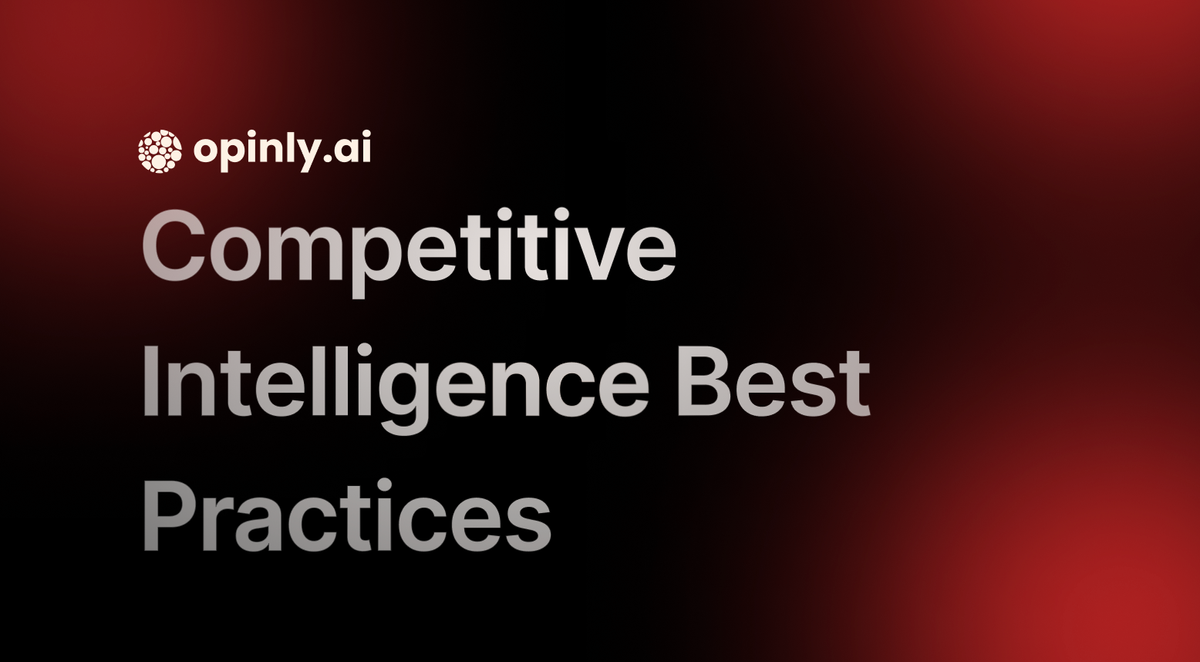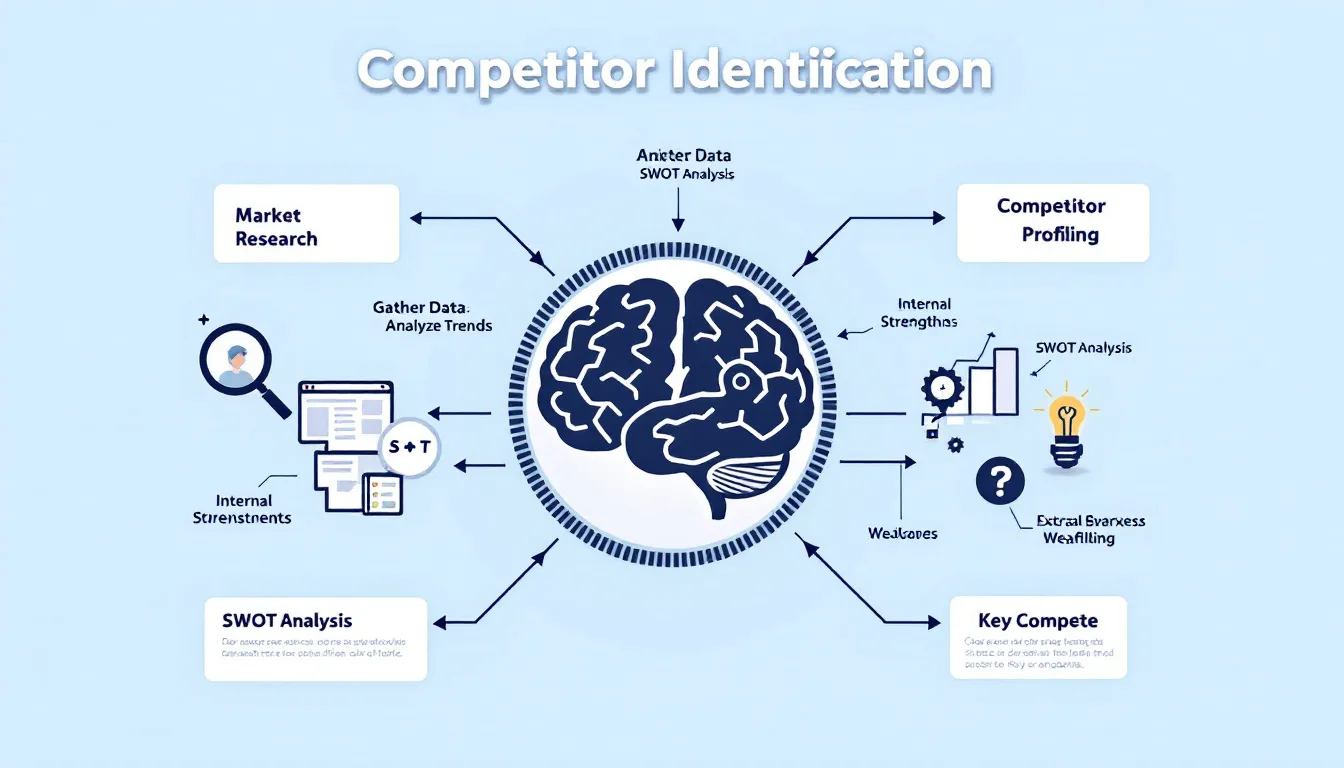Competitive Intelligence Best Practices: A Step-By-Step Guide
Discover effective competitive intelligence practices that drive business success. Learn strategies to stay ahead in your industry. Read the article now!

Need practical tips for gathering and using competitor data? In this guide, we cover competitive intelligence best practices that help you turn insights into action and stay ahead in the market.
Key Takeaways
- Competitive Intelligence (CI) involves proactive data collection and analysis to inform business strategy, helping organizations anticipate competitor moves and uncover opportunities.
- Effective CI is driven by clear business objectives, key competitor identification, and the use of reliable data sources, all of which facilitate actionable insights and alignment with overall strategic goals.
- Integrating AI and automation into CI processes enhances efficiency in data collection and analysis, allowing businesses to adapt to market changes and emerging trends more swiftly.
Understanding Competitive Intelligence

Competitive intelligence (CI) is the art and science of gathering competitive intelligence data-driven insights about your competitors to inform your business strategy. Modern CI methods include social media monitoring, scenario planning, and data mining, enabling businesses to stay one step ahead in the competitive landscape. But it’s more than just data collection; it’s about creating a competitive intelligence program to gain a strategic advantage.
Leveraging CI allows businesses to anticipate competitors’ moves, capitalize on their weaknesses, and unearth hidden opportunities. This proactive approach not only boosts market share but also ensures brand longevity. Imagine knowing your competitor’s strategy before they even execute it—CI makes this possible.
Ongoing competitor tracking, or competitive monitoring, optimizes operations and streamlines processes. This continuous process helps in product development and benchmarking, ensuring that your offerings are always a notch above the rest. CI is not a one-time effort but an ongoing commitment to staying ahead of the curve.
Setting Clear Business Objectives
Effective CI starts with aligning your intelligence efforts with business objectives. Without clear objectives, the data gathered can become a sea of irrelevant information. Understanding strategic goals through engagement with company leadership is vital. A ‘listening tour’ across teams can reveal where CI can significantly impact.
Integrating CI into strategic discussions improves decision-making on pricing models and marketing strategies. A reliable schedule for delivering insights ensures that stakeholders receive timely, actionable intelligence. Transparent communication about priorities and expectations helps align CI initiatives with broader business goals.
Sustaining impactful CI requires balancing short-term wins with long-term strategic contributions. Transforming competitive intelligence into actions requires linking competitor activities with customer demands, ensuring that your strategies are always relevant and impactful.
Identifying Key Competitors

Identifying and understanding key competitors is fundamental in the CI process. This involves assessing competitors based on their relevance to your products, geographical reach, target audience, and overall business factors. Customer research can provide valuable insights into who your competitors are and how their brands are perceived.
It’s crucial to evaluate competitors based on their influence on market dynamics and revenue-generating capabilities. Companies should focus on those competitors that have the greatest impact on their market share and revenue. Market intelligence, a subset of CI, helps in assessing market size, growth potential, and trends affecting competitors.
Geographical reach and operational regions determine the relevance of competitors. Strategic CI focuses on long-term trends and overarching business strategies to understand the competitive landscape better. Prioritizing competitors that significantly impact revenue makes CI efforts more targeted and effective.
Selecting Effective Data Sources
Choosing the right data sources is pivotal for meaningful competitive intelligence. Common sources include public records, news articles, industry reports, competitors’ websites, product releases, customer reviews, social media, online reviews, forums, trade shows, and industry networks. Each of these sources offers unique insights that can enrich your CI data pool.
Subscription-based market research firms provide in-depth reports that can significantly enhance your competitive analysis. Additionally, change monitoring tools can alert your team to updates on competitors’ websites, indicating important changes. Social media platforms are invaluable for tracking competitors’ activities and public interactions.
Effective CI relies on a mix of primary and secondary data sources. Primary sources include direct observations and interviews, while secondary sources encompass published reports and online content. This comprehensive approach ensures that your CI is both broad and deep, covering all necessary angles.
Conducting Detailed Competitor Analysis
Conducting a detailed competitor analysis is where the real magic of CI happens. This process involves studying competitors’ strengths and weaknesses, product offerings, pricing strategies, marketing campaigns, and operations. This allows businesses to spot opportunities, anticipate market shifts, and stay ahead of the competition.
Customer feedback analysis can reveal which competitors are viewed favorably by your target market. Participating in or observing industry events can provide insights into new product developments and marketing strategies. Understanding competitors’ sales strategies leads to more effective tactics in addressing customer concerns.
Advanced techniques like the BCG growth-share matrix help prioritize products based on their market performance and competition. Identifying market gaps by analyzing competitors’ offerings and recognizing unaddressed customer needs can position your business as the solution to competitors’ shortcomings. Organized analysis of gathered CI is crucial for drawing actionable insights.
Utilizing Competitive Intelligence Tools

Competitive intelligence tools are indispensable in facilitating the collection and analysis of extensive data. These tools enable businesses to adapt to competitor strategies effectively. Leading competitive intelligence platforms use advanced AI and machine learning to provide actionable insights through a competitive intelligence platform.
CI tools enhance business strategies by informing pricing, feature development, and market positioning. Real-time tracking of competitors’ marketing activities and performance metrics is a key feature of these tools. Choosing the right tools involves considering budget, scalability, and integration.
Comprehensive CI platforms help manage CI workflows and streamline processes. Technology automates tasks and improves efficiency in CI research. As the volume of data grows, these tools help businesses organize and extract actionable insights.
Implementing a Competitive Intelligence Framework
Implementing a competitive intelligence framework ensures a structured approach to data gathering and analysis. The first step is defining the framework’s scope. Balancing immediate, ad hoc intelligence needs with long-term systematic monitoring is crucial for effective CI.
Success in a CI initiative requires identifying and aligning relevant stakeholders. Engaging stakeholders helps measure CI’s influence across departments. Evaluating the cost of generating insights can help assess a CI program’s efficiency.
As the importance of CI rises, organizations are allocating larger budgets and expanding their CI teams. The time taken to gather and analyze insights can affect how quickly a company can react to competitive moves. A well-implemented CI framework ensures timely and effective decision-making.
Turning Insights into Actionable Strategies

Transforming CI findings into actionable strategies influences product development and market positioning. Organizations should cultivate a culture of intelligence to integrate insights into daily operations and maximize impact.
Sales teams rely heavily on CI to identify key decision-makers and tailor their strategies effectively. Tracking win rates reveals the effectiveness of CI for the sales team. Marketing departments use CI to optimize advertising and tailor messaging to target markets.
Real-world examples, like Netflix’s transition to streaming, show how CI can lead to significant strategic shifts. Understanding why deals were won or lost through win/loss interviews helps refine competitive strategies.
Measuring the Impact of Competitive Intelligence
Measuring CI impact refines marketing strategies and increases market share. Strategic CI provides a deeper understanding of competitors’ capabilities, helping anticipate market shifts and develop proactive strategies.
Focusing on essential areas that vary by company goals and industry is key when measuring CI. Consistent tracking, analysis, and reporting of metrics and KPIs ensure ongoing CI success. Regular metric reviews refine the CI approach.
Rapidly shifting market conditions make regular CI updates essential for timely decisions. Ethical sourcing of CI is important to build trust with stakeholders and avoid reputational risks. The CI process must adhere to ethical standards and comply with legal regulations.
Maintaining Ethical Standards
Adhering to ethical standards in CI practices is paramount. Legal compliance prevents activities that could lead to lawsuits or reputational harm. Respecting privacy is a fundamental ethical obligation, forbidding unauthorized access to sensitive information.
CI practices must balance transparency with ethical information-gathering methods to maintain trust. Fair competition and avoiding deceptive practices are essential. Establishing professional standards and codes of conduct ensures ethical behavior within CI practices.
Leveraging Artificial Intelligence and Automation

AI and automation enhance CI’s speed and efficiency in data collection. AI tools continuously monitor online data sources, automating the extraction and compilation of relevant competitive insights.
Machine learning algorithms identify patterns in data, offering actionable insights into competitor strategies. AI-powered solutions facilitate real-time intelligence sharing, which is crucial for timely decision-making in competitive landscapes.
Combining human expertise with AI data analysis leads to more informed and nuanced competitive strategies. Tools like InfoLab filter qualitative data sources, improving CI information relevance.
Staying Updated with Emerging Trends
Keeping up with emerging CI trends is essential for maintaining a competitive edge. Proactive use of CI helps businesses stay ahead of market trends and consumer preferences. Continuously adapting to trends helps businesses improve strategic decisions and foster long-term success.
Ongoing CI gathering ensures your strategies remain relevant and effective.
Summary
In this guide, we’ve journeyed through the essentials of competitive intelligence, from understanding its core principles to implementing actionable strategies. We’ve explored the importance of aligning CI efforts with business objectives, identifying key competitors, and selecting effective data sources. Detailed competitor analysis, the utilization of advanced CI tools, and the establishment of a robust CI framework are critical steps in staying ahead in the competitive landscape.
By leveraging artificial intelligence and automation, businesses can enhance the speed and efficiency of their CI efforts. Staying updated with emerging trends ensures that your strategies remain relevant and effective. Remember, maintaining ethical standards in CI practices is paramount to building trust and avoiding reputational risks. Armed with these insights, you’re now ready to gain that competitive edge and drive your business towards long-term success.
Frequently Asked Questions
What is competitive intelligence, and why is it important?
Competitive intelligence is the process of collecting and analyzing information about competitors to shape business strategy. It is important because it helps businesses anticipate competitors' actions, exploit their weaknesses, and identify new opportunities, ensuring a strategic edge in the market.
How do I align competitive intelligence efforts with my business objectives?
To align competitive intelligence with your business objectives, engage with leadership to clarify strategic goals and involve various teams in discussions to ensure CI informs decision-making effectively. This integration will enhance the overall alignment and impact of your efforts on the company's success.
What are some effective data sources for gathering competitive intelligence?
To gather effective competitive intelligence, utilize public records, news articles, industry reports, and competitors' websites. Additionally, consider leveraging social media, customer reviews, and subscription-based market research firms for deeper insights.
How can I measure the impact of my competitive intelligence efforts?
To effectively measure the impact of your competitive intelligence efforts, consistently track relevant metrics and KPIs aligned with your company's goals. Regularly analyze these metrics to refine your approach, ensuring ethical sourcing and compliance.
What role does artificial intelligence play in competitive intelligence?
Artificial intelligence significantly enhances competitive intelligence by automating data collection and analysis, allowing firms to rapidly gather insights from large datasets. This combination of AI tools and human expertise facilitates the development of informed and effective competitive strategies.
